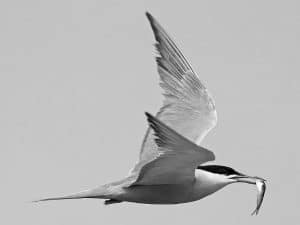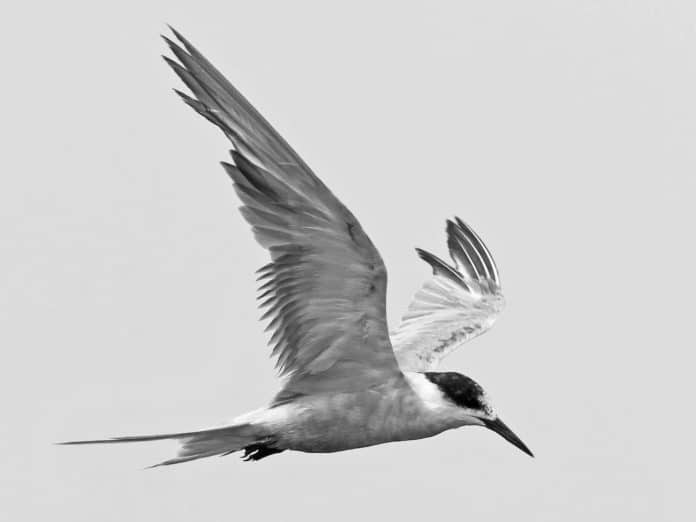Introduction to the White-Cheeked Tern
The White-Cheeked Tern, scientifically known as Sterna repressa, is a beautiful and graceful seabird that can be found along the coastlines and inland waters of Tanzania. With its striking white plumage and distinct black cap, this species stands out among its avian counterparts. The White-Cheeked Tern in Tanzania is renowned for its exceptional aerial acrobatics, which make it a delight to observe and photograph in flight.
Habitat and Distribution of the White-Cheeked Tern in Tanzania

The White-Cheeked Tern is widely distributed along the Tanzanian coast and the nearby islands of Zanzibar and Pemba. These birds prefer to inhabit tropical and subtropical regions, making Tanzania an ideal location for their breeding and nesting activities. They can be found in a variety of habitats, including sandy beaches, rocky cliffs, and mangrove forests. During the breeding season, they often gather in large colonies on secluded islands or remote stretches of coastline.
Physical Characteristics and Behavior of the White-Cheeked Tern
The White-Cheeked Tern is a medium-sized seabird, measuring around 30 centimeters in length. It has a sleek body with long, slender wings and a deeply forked tail, which aids in its impressive aerial maneuvers. The bird’s most distinctive feature is its white plumage, contrasting with a black cap that extends from its bill to its nape. Additionally, it has a red bill and legs, adding a splash of color to its appearance.
In terms of behavior, the White-Cheeked Tern is highly social and gregarious, often seen in large flocks during both breeding and non-breeding seasons. These birds are excellent flyers and are known for their agility in the air. They perform captivating aerial displays, including swooping, diving, and sudden changes in direction. These acrobatic feats are not only visually stunning but also serve practical purposes such as hunting for prey and defending their territory.
Breeding and Nesting Habits of the White-Cheeked Tern
Breeding season for the White-Cheeked Tern typically occurs between September and March. During this time, they form breeding colonies on small islands or isolated sections of the coastline. The nests are constructed on the ground using materials such as twigs, grass, and feathers. Females usually lay one or two eggs, which both parents take turns incubating for approximately three weeks.
Once the chicks hatch, they are cared for by both parents, who provide them with food and protection. The young terns grow rapidly and develop their flight feathers within a few weeks. After around 40 days, they are ready to take their first flight, marking the end of the nesting period.
Feeding Habits and Diet of the White-Cheeked Tern
The White-Cheeked Tern is a skilled hunter, specializing in catching small fish near the water’s surface. They employ a unique feeding technique known as plunge-diving, where they hover above the water and then dive headfirst to capture their prey. This method allows them to swiftly and accurately catch fish, ensuring a steady food supply for themselves and their offspring.
Apart from fish, the White-Cheeked Tern also feeds on various marine invertebrates such as shrimp, squid, and crustaceans. They are opportunistic feeders and adapt their diet based on the availability of resources in their environment.
Conservation Status and Threats to the White-Cheeked Tern Population in Tanzania

The White-Cheeked Tern population in Tanzania is currently listed as Least Concern by the International Union for Conservation of Nature (IUCN). However, like many other bird species, they face several threats that could potentially impact their numbers in the future.
One significant threat to the White-Cheeked Tern population is habitat loss and degradation. Coastal development, tourism, and pollution pose risks to their breeding and feeding grounds. Additionally, disturbance from human activities, such as boating and beach recreation, may disrupt nesting colonies and cause stress to the birds.
Conservation efforts are crucial to ensuring the long-term survival of the White-Cheeked Tern. Protecting their breeding sites, implementing responsible tourism practices, and raising awareness about the importance of these birds to the ecosystem are vital steps in safeguarding their population.
Best Places to Spot and Photograph White-Cheeked Terns in Tanzania
Tanzania offers numerous excellent locations for observing and photographing White-Cheeked Terns in their natural habitat. One such place is the coastal region of Dar es Salaam, where these seabirds can be seen flying along the shoreline or resting on sandy beaches. Mnemba Island, located off the coast of Zanzibar, is another hotspot for White-Cheeked Tern sightings. The pristine beaches and crystal-clear waters provide a picturesque backdrop for capturing these elegant birds in flight.
For avid birdwatchers and photographers, Saadani National Park is a must-visit destination. This unique park is situated at the intersection of the Wami River and the Indian Ocean, offering a diverse range of habitats for various bird species, including the White-Cheeked Tern. Exploring the park’s mangrove forests, riverbanks, and coastal areas can lead to unforgettable encounters with these stunning seabirds.
Tips for Observing and Photographing White-Cheeked Terns in Flight
Observing and photographing White-Cheeked Terns in flight requires patience, skill, and some preparation. Here are a few tips to enhance your experience:
- Choose the right equipment: Use a camera with a good zoom lens to capture the intricate details of the birds in flight. A tripod or monopod can help stabilize your shots, especially in challenging lighting conditions.
- Timing is key: Plan your visit during the early morning or late afternoon when the light is softer and more favorable for photography. This will also increase your chances of witnessing the terns’ aerial displays.
- Study their behavior: Observe the flight patterns and feeding behavior of the terns to anticipate their movements. This knowledge will enable you to position yourself for the best photo opportunities.
- Be respectful: Maintain a safe distance from the birds to avoid causing stress or disturbance. Use binoculars or a telephoto lens to observe them closely without intruding on their natural behavior.
- Practice patience: Capturing the perfect shot may require waiting for the right moment. Take your time and enjoy the experience of witnessing these magnificent birds in their element.
Interesting Facts about the White-Cheeked Tern

- The White-Cheeked Tern is known for its long-distance migrations, with some individuals traveling as far as Europe and Asia during non-breeding seasons.
- These birds are highly vocal and communicate through a variety of calls, including sharp, high-pitched notes and trilling sounds.
- The White-Cheeked Tern has an average lifespan of around 10-15 years in the wild.
- They are highly social birds and often form mixed flocks with other tern species during migration.
- The White-Cheeked Tern plays a vital role in the marine ecosystem by controlling fish populations and redistributing nutrients through their droppings.
Conclusion: Appreciating the Beauty and Grace of the White-Cheeked Tern in Tanzania
The White-Cheeked Tern is a true marvel of nature, with its elegance, aerial acrobatics, and striking plumage captivating observers and photographers alike. Tanzania provides a rich and diverse environment for these seabirds, offering opportunities to witness their remarkable behaviors and photograph their graceful flights. By understanding and appreciating the beauty of the White-Cheeked Tern, we can contribute to the conservation efforts needed to safeguard their population for generations to come.

































